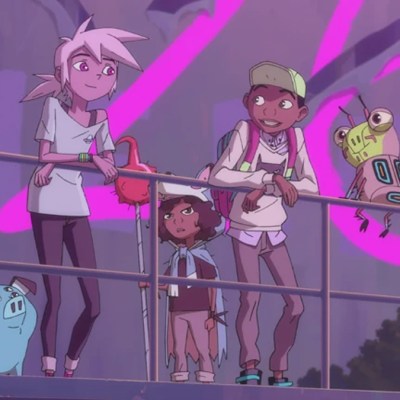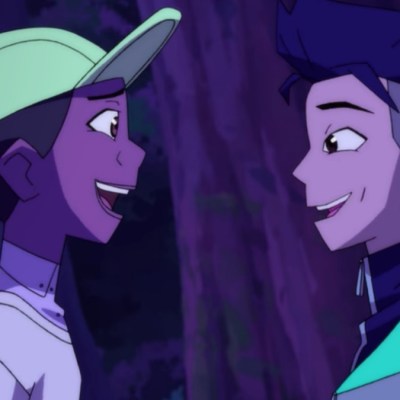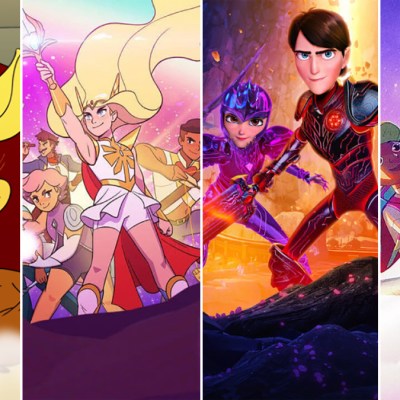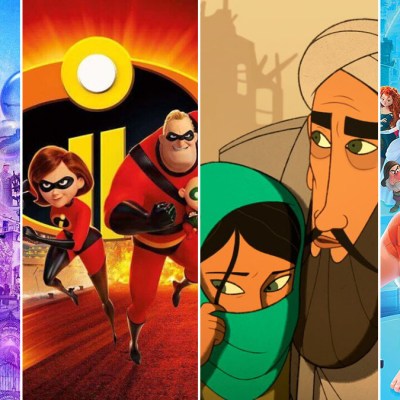How Kipo and the Age of Wonderbeasts Codes Blackness
Kipo and the Age of Wonderbeasts is part of a burgeoning genre of children’s animation series that know how to approach socially conscious storytelling.
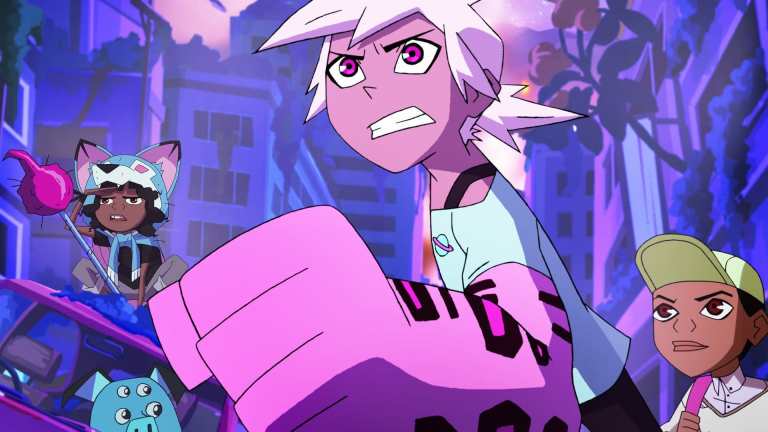
The following contains spoilers for Kipo and the Age of Wonderbeasts season 2.
In the first season of Kipo and the Age of Wonderbeasts, Scarlemagne, a mutated mandril who, like a number of animals within this world, now speaks English and walks on two feet, is introduced wearing British-revolutionary-era clothing. It’s a unique, strange, and seemingly random detail to introduce the show’s first key villain like that. Initially, it seems as though this is just his gimmick, the specific “theme” that the bad guy attached himself to, part of his crazed aspirations so tied to his imaginations. But it isn’t until the second season of Kipo and the Age of Wonderbeasts that the purpose behind the clothing becomes clear. The show uses Scarlemagne’s attire to pinpoint a powerful and prevalent theme throughout its run, relating to race, and the history, iconography, and visuals of how race is depicted and affected.
You see, Scarlemagne controls his human charges with his pheromones, which were enhanced when he became a “mute,” but the second season has them literally, physically building his idealized new utopia. Scarlemagne rants with the wide-eyed, vicious passion of Magneto, darkly envisioning a mute-only world with no humans except those under his control. Dressed as he is, he forces a light-skinned human who collapses under the strain of too much work back onto his feet, refusing what he sees as “slacking.” it’s clear that his treatment of his humans is meant to parallel the treatment of early British/colonists’ treatment of Black American slaves.
Obviously, this isn’t meant to be a one-to-one comparison. And it shouldn’t be. Kipo and the Age of Wonderbeasts very much functions in its own specific universe, with its fantastical science, whimsical energy, and idealized perspective that fits into the world it created. But much of the imagery and visual and narrative choices seem to comment and reflect on the racial issues that exist today. I’m reminded of Steven Universe in this regard, which used its depictions of Gems, Fusions, and the trials and tribulations of Beach City to depict and showcase sex and genderr issues. If Steven Universe can so effectively reflect those issues, and the various ways those issues can play out and represent, it’s very much possible that Kipo can do the same, in regards to race.
Kipo’s examination of race starts with a rarity of television, particularly in animation: the leads are Black. Today, there are more choices in regards to people of color leads in cartoons: Craig of the Creek, Home: Adventure of Tip and Oh, Doc McStuffins, and The Cassagrandes, to name a few. Yet Kipo’s very premise adds extra layers and weight to this set up. The surface world of earth is genuinely dangerous, and each character, still couched in their Blackness, represents different perspectives. Kipo herself is naive, new to the specific dangers of society, a teenager slowly becoming aware of the truth of the world around her. Her relatively safe and secure upbringing allows her to approach new people and new encounters optimistically, with a penchant for compassion and discussion to solve problems–an admittedly welcome approach, in having a lead as a role model for younger viewers figuring out how to navigate this very scary, contemporary world.
Wolf, who grew up in the shadow of this hostile world, knows pain, suffering, and survival–essentially, “living on the street” makes her perspective hyper-aware of animosities towards her kind. (The character designs, too, are part of this dichotomy: Kipo’s cut, stylized, processed hair contrasts starkly with Wolf’s messy, overgrown, nappy hair.) If Kipo represents one end of the spectrum, and Wolf the other, then Benson is somewhere in the middle: street-wise and savvy, also attuned to the dangers of the surface, but also driven by the better nature of mutes and humans, finding solace and hope in brief moments: a cassette player, a mute friendship in Dave, a carnival run by rats that functions as a beacon of mute/human harmony.
The triple perspective of Black people, in particular, of Black youth, responding to this mute society and the various ways it shows its contempt towards “humans”–them–is momentous. It adds extra weight to the specific choices that litter the surface world in ways worth exploring. Consider, for example, the graffiti written on the various walls and surfaces that demean humans, seen in season one’s “Ratland.” It’s disturbing enough to see in the context of the show, but it’s much more pointed in the view of a Black lens (it’s somewhat disappointing, and odd, that we don’t see this sporadically throughout the surface world).
Or take season two’s “The Ballad of Brunchington Beach,” an episode in which a restaurant refuses to allow or serve humans. Again, many viewers will already recognize the concept: any place that refuses to serve the protagonists in any show is, at best, an obstacle, and at worst, a race metaphor. It’s extra telling, I think, that Dave forgets this rule; it’s hard to tell if he genuinely forgot, or is so self-absorbed that he doesn’t tell them, but it feels earnest in how “throwaway” people often visualize animosity towards Black people.) But in the eyes of our Black protagonists, it’s specific, historically-fraught, and prescient. In addition, “The Ballad of Brunchington Beach” contains a scene in which a couple of mutes dressed as humans sing and act on a stage for the restaurant’s patrons, portraying the humans as evil, stupid, and dangerous. Again, through the Black lens, it hints at the history and iconography of minstrel shows and their well-known, insidious portrayal of Black people.
Many other details about the characters and the surface world in Kipo add flavors, however uncomfortable, to the specific plights of many Black Americans. Wolf’s backstory includes surviving on the surface world’s “streets” and a deeply disturbing and dark conflict with a wolf “foster” family. The broad range of responses to the appearances of our protagonists in the various society of mutes–from the Timbercats eventual acceptance, to the Newton Wolves ultimate hostility, to the change in heart and perspective of one single, solitary Mod Frog, a character who went from champing at the bit to capture Kipo, Benson, and Wolf for Scarlemagne (a kind of… slave catching vibe, if you will), to embracing and even somewhat enjoying their company. Not every episode and every moment engages in metaphorically exploring race, but not every episode of Steven Universe metaphorically explored sex and gender. And yet, in both shows, the episodes outside that lens didn’t detract from the looming racial/gender issues, respectively. In the language of the internet, even those episodes “hit different.”
Which brings me to the plot point of Kipo being part-mute, and the narrative which reveals this backstory.
Kipo and the Age of Wonderbeasts can tell its story the way it sees fit. It has a grand, ambitious vision, and a willingness to tackle it in pretty fascinating, fantastic ways. But I would argue the narrative track the show is taking to engage with this specific storyline is walking a razor’s edge. The use of science experimentation on a fetus, on a person of color, functions wholly differently in this context, considering the historical, ethical, and questionable relationship between medicine and Black people.
Kipo and the Age of Wonderbeasts tries to mitigate the thorniness of this plotting: when Kipo’s father reveals what they did to her, the show feigns a sense of horror at this, only for Kipo to shout her excitement and approval at what happened to her. The audience is supposed to take that at face value, to move on from this notion and accept everything else about this plot that follows, but it’s just near impossible to shake the ethical dilemma deeply inherent in this revelation. To not even engage in the nature of what’s revealed here feels disingenuous, and that looms over the second half of season two.
Kipo and the Age of Wonderbeats attempts to make this more of an allegory to the notion of being mixed-raced. Kipo, herself, is already mixed-raced: her father is Black, and her mother is Asian. Kipo, therefore, being part-mute, tracks. However, the part-mute concept is generated from scientific interference and experimentation, and that can’t be ignored. It’s also infused into a complex backstory that involves testing various formulas on animals to find the one that created mutes, in order to reverse it, to return mutes back to animals and allow humans to reclaim the surface. The testing inadvertently created Hugo, aka, Scarlemagne. Dr. Emilia, a new and future villain in the making, led the testing, and by the end of the second season, will be leading a batch of humans to “fight back” against the mutes.
Kipo works overtime to hone in on Emilia as a particular type of evil. She wants to return the surface world to “normal,” but the dialogue she’s given is more often along the lines of “silencing the mutes,” which is easier to define in villainous terms. This plot point seems rushed. It’s possible to provide an rationale of Emilia’s worldview–returning mutes to the way they were–as regular animals–so they can return to the surface. But it’s also possible to point out the villainous consequences in that rationale–which inevitably seeks to snuff out the consciousness and self-awareness of mutes, who are real, exist, and exhibit the behaviors and mentailities that we attribute to a shared humanity. In theory, this could reflect a broader commentary on accepting changes in the world, and the shifting relationships between humans and mutes; i.e., Black people and society. (There’s a chance they’ll do this in the third season, similar to how they provided sympathy for Scarlemagne in the second season episode, literally titled: “Sympathy for the Mandrill.” I should say, however, I found some of the developments of this episode, and the endgame of the character, chunkily handled.)
But also, with the ethically-grey uses of science, and the part-mute nature of Kipo acting as a potential lens to view things now from the mute point of view, there’s a concern that, at worst, things may take on a “both sides” or a “reverse racism” kind of vibe. Showcasing the struggles of (Black) humans in a mute-controlled society, only to change it to a narrative of humans attempting to forcefully attack the mutes, is concerning, particularly since the tone doesn’t seem to be a desperate, justified “fight back” or “resist,” but more of a condemnation of group-driven, anger-driven violence in general. With all of this occurring on the scientific experiment plot point, it just comes across suspect.
That’s the nature of Kipo and the Age of Wonderbeasts, and its ambitious willingness to explore the messiness of racial issues, even if the plotting is starting to get a bit muddled and sketchy as the show goes along. (Steven Universe wasn’t perfect in regards to gender either!) In any case, it’s novel and new for kids animation, and so highly aware of how its narrative is coming across, that even its more clunky and wonky storytelling choices are worth noting and letting play out. Who knows, it may be surprising and revelatory in such new and novel ways. Similar to how Steven taught a generation of young viewers how to let compassion and kindness guide them through encountering and dealing with gender concerns, Kipo herself could be a beacon through the thorny, fraught issues of race.
